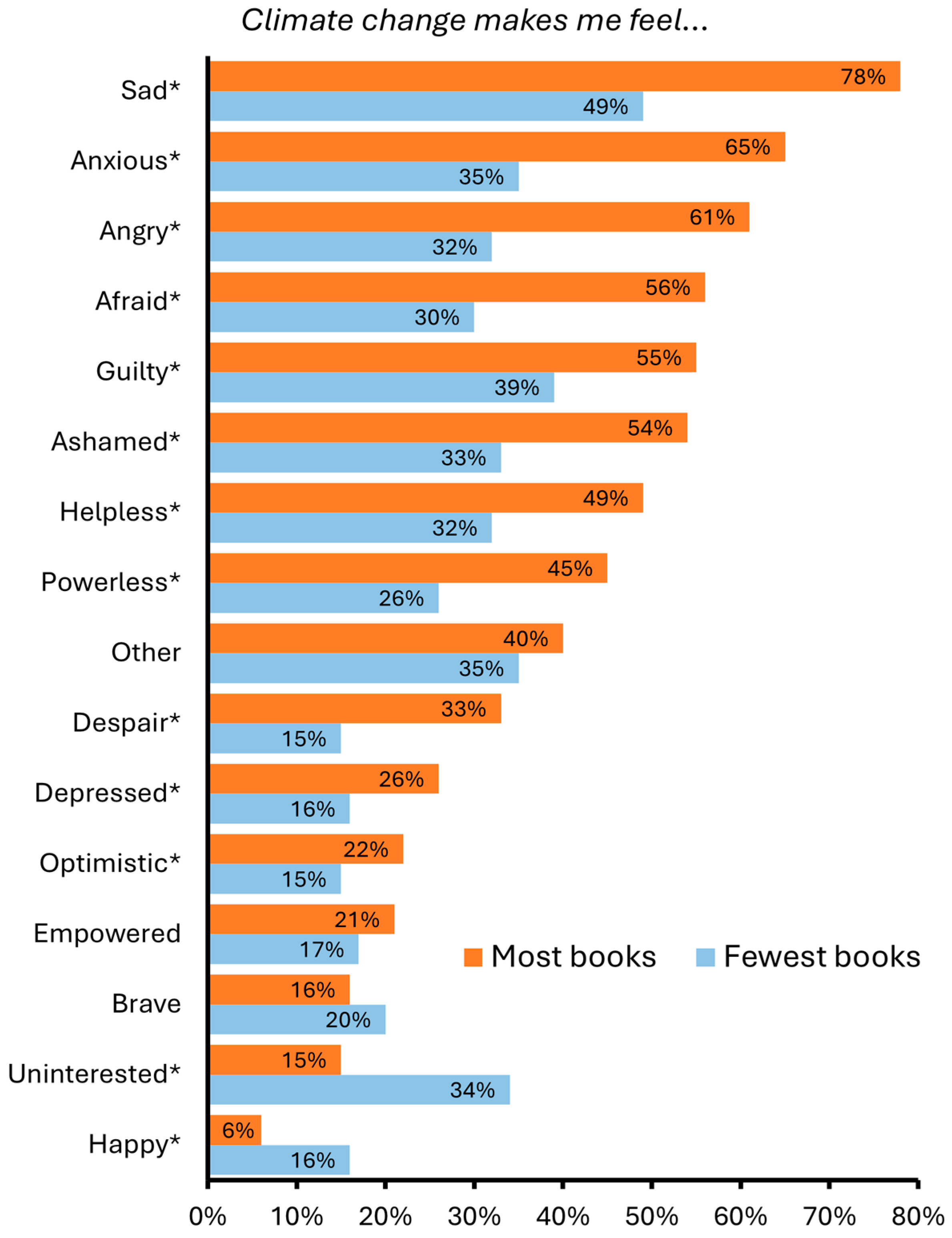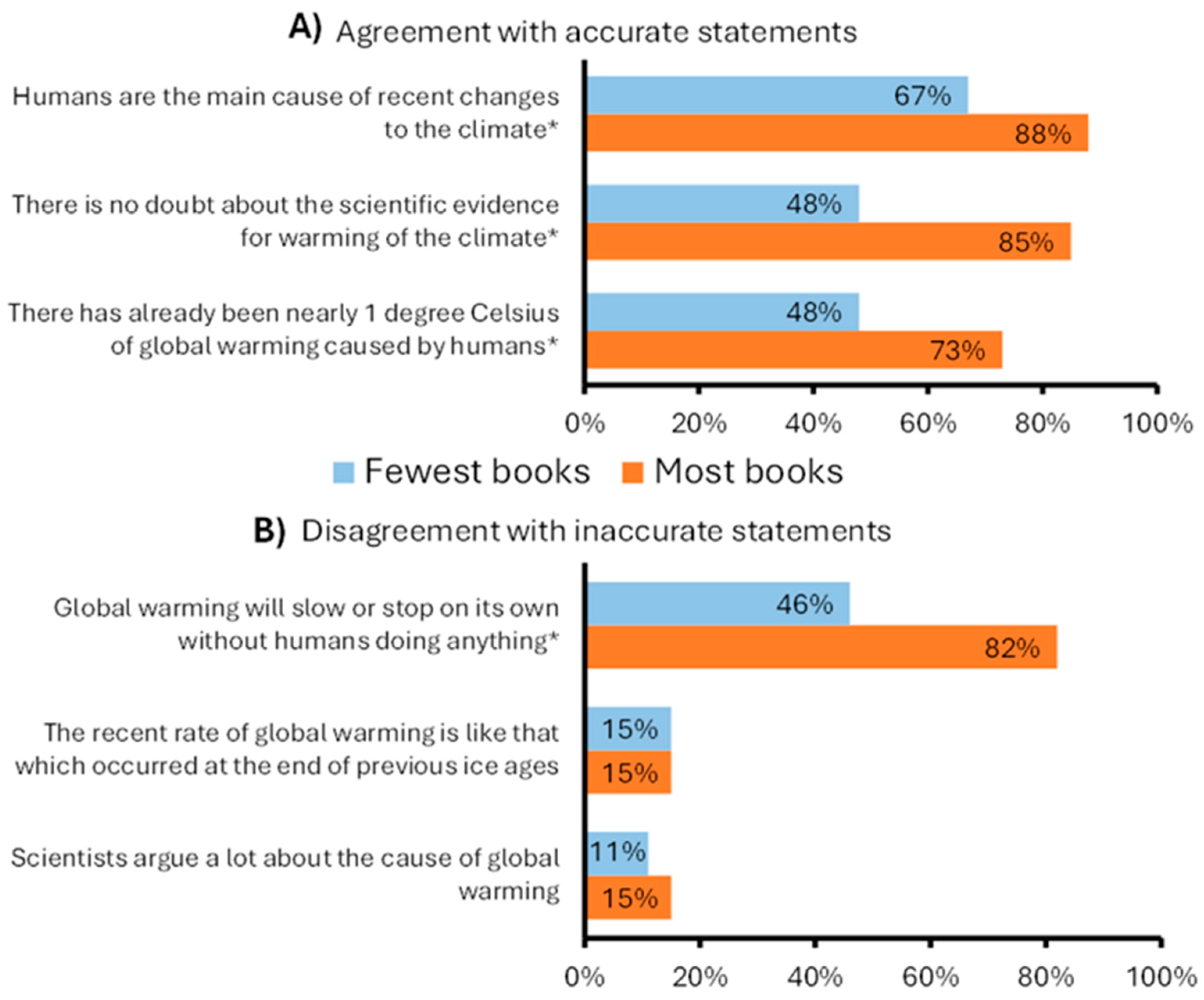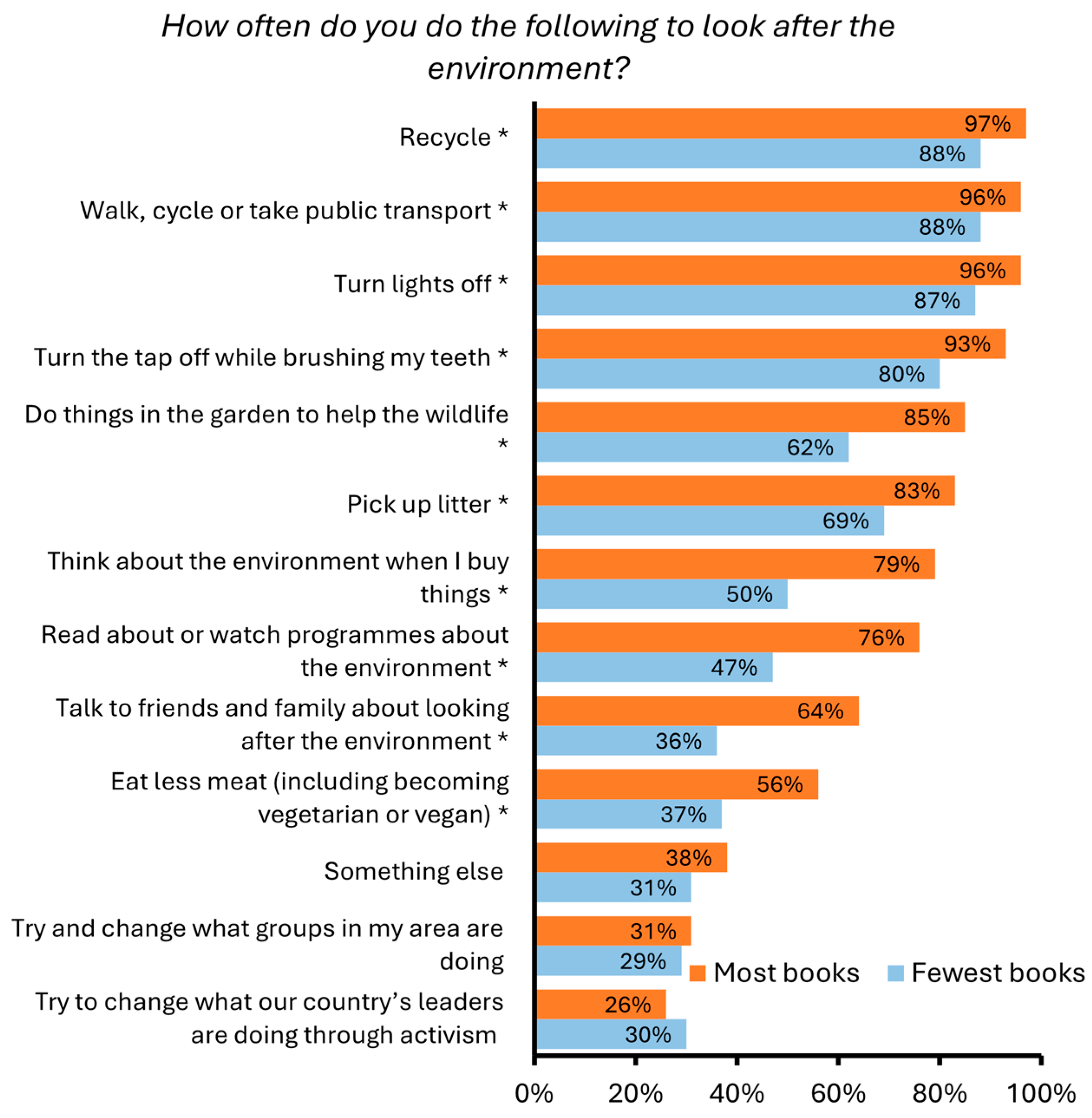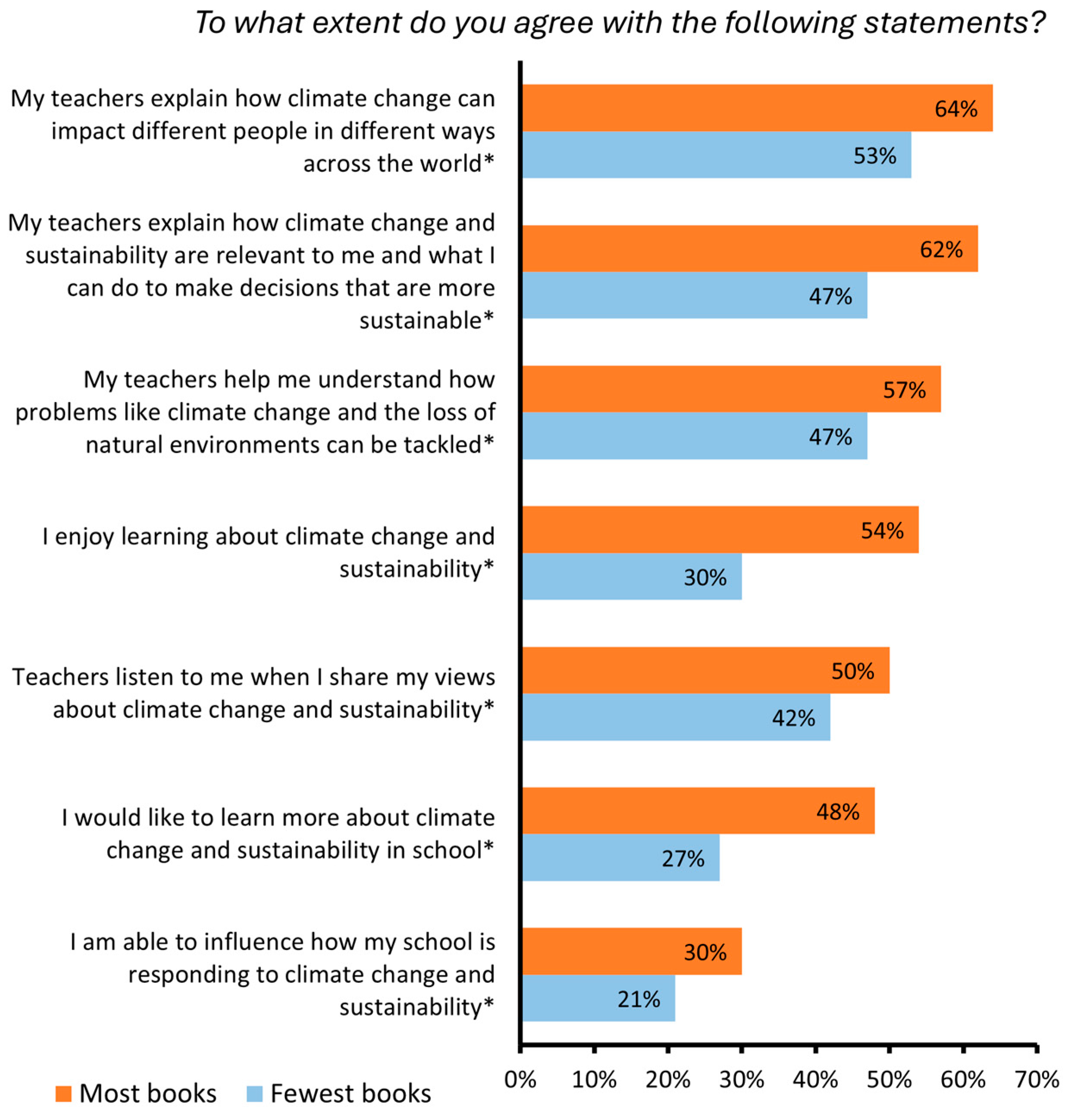Socioeconomic Variation in Emotional, Cognitive, and Behavioural Engagement with the Climate Crisis in England: Perspectives for Education
Abstract
1. Introduction
1.1. Responses to the Climate Crisis: Eco-Anxiety and Pro-Environmental Behaviour
1.2. Socioeconomic Inequalities and Correlations with Eco-Anxiety
1.3. The Role of Climate Change and Sustainability Education in Fostering Emotional, Cognitive, and Behavioural Engagement with the Climate Crisis
1.4. Research Context: Climate Change and Sustainability Education in England
1.5. Research Questions and Approach
2. Materials and Methods
2.1. Survey Instrument
2.2. Recruitment and Survey Administration
2.3. Sample
2.4. Analysis
3. Results
3.1. Emotional and Cognitive Responses to Climate Change
3.2. Engagement in Pro-Environmental Behaviour
3.3. Experiences and Perspectives of Climate Change and Sustainability Education
4. Discussion
4.1. Socioeconomic Variation in Emotional, Cognitive, and Behavioural Engagement with Climate Change
4.2. Addressing Socioeconomic Inequities in Experiences of Climate Change and Sustainability Education
4.3. Limitations and Recommendations for Future Research
5. Conclusions
Supplementary Materials
Author Contributions
Funding
Institutional Review Board Statement
Informed Consent Statement
Data Availability Statement
Acknowledgments
Conflicts of Interest
References
- Anneser, E., Levine, P., Lane, K. J., & Corlin, L. (2024). Climate stress and anxiety, environmental context, and civic engagement: A nationally representative study. Journal of Environmental Psychology, 93, 102220. [Google Scholar] [CrossRef] [PubMed]
- Aylward, B., Cunsolo, A., Vriezen, R., & Harper, S. L. (2022). Climate change is impacting mental health in North America: A systematic scoping review of the hazards, exposures, vulnerabilities, risks and responses. International Review of Psychiatry, 34(1), 34–50. [Google Scholar] [CrossRef] [PubMed]
- Berry, H. L., & Peel, D. (2015). Worrying about climate change: Is it responsible to promote public debate? BJPsych International, 12(2), 31–32. [Google Scholar] [CrossRef]
- Boluda-Verdú, I., Senent-Valero, M., Casas-Escolano, M., Matijasevich, A., & Pastor-Valero, M. (2022). Fear for the future: Eco-anxiety and health implications, a systematic review. Journal of Environmental Psychology, 84, 101904. [Google Scholar] [CrossRef]
- Bouman, T., Verschoor, M., Albers, C. J., Böhm, G., Fisher, S. D., Poortinga, W., Whitmarsh, L., & Steg, L. (2020). When worry about climate change leads to climate action: How values, worry and personal responsibility relate to various climate actions. Global Environmental Change, 62, 102061. [Google Scholar] [CrossRef]
- British Science Association. (2023). Climate change in secondary schools: Young people’s views of climate change and sustainability education. Available online: https://www.britishscienceassociation.org/future-forums (accessed on 21 March 2025).
- Brosch, T., & Steg, L. (2021). Leveraging emotion for sustainable action. One Earth, 4(12), 1693–1703. [Google Scholar] [CrossRef]
- Bruckner, B., Hubacek, K., Shan, Y., Zhong, H., & Feng, K. (2022). Impacts of poverty alleviation on national and global carbon emissions. Nature Sustainability, 5(4), 311–320. [Google Scholar] [CrossRef]
- Butt, S., Clery, E., & Curtice, J. (2022). British social attitudes: The 39th report. National Centre for Social Research. Available online: https://natcen.ac.uk/sites/default/files/2023-08/bsa39_regions.pdf (accessed on 21 March 2025).
- Cattan, S., Fitzsimons, E., Goodman, A., Phimister, A., Ploubidis, G., & Wertz, J. (2022). Early childhood inequalities. Institute for Fiscal Studies. Available online: https://ifs.org.uk/publications/early-childhood-inequalities-0 (accessed on 21 March 2025).
- Chawla, L. (2020). Childhood nature connection and constructive hope: A review of research on connecting with nature and coping with environmental loss. People and Nature, 2(3), 619–642. [Google Scholar] [CrossRef]
- Cheng, J. C.-H., & Monroe, M. C. (2012). Connection to nature: Children’s affective attitude toward nature. Environment and Behavior, 44(1), 31–49. [Google Scholar] [CrossRef]
- Children’s Commissioner for England. (2021). Public services for children: Lessons from COVID-19 and the integration of public services [Written evidence submitted to the House of Commons Health and Social Care Committee]. Available online: https://committees.parliament.uk/writtenevidence/9361/html/ (accessed on 21 March 2025).
- Cohen, J. (1988). Statistical power analysis for the behavioral sciences. Lawrence Earlbaum Associates. [Google Scholar]
- Colombo, S. L., Chiarella, S. G., Lefrançois, C., Fradin, J., Raffone, A., & Simione, L. (2023). Why knowing about climate change Is not enough to change: A perspective paper on the factors explaining the environmental knowledge-action gap. Sustainability, 15(20), 14859. [Google Scholar] [CrossRef]
- Comtesse, H., Ertl, V., Hengst, S. M. C., Rosner, R., & Smid, G. E. (2021). Ecological grief as a response to environmental change: A mental health risk or functional response? International Journal of Environmental Research and Public Health, 18(2), 734. [Google Scholar] [CrossRef]
- Department for Education. (2014). National curriculum in England: Framework for key stages 1 to 4. Available online: https://www.gov.uk/government/publications/national-curriculum-in-england-framework-for-key-stages-1-to-4 (accessed on 21 March 2025).
- Department for Education. (2022). Sustainability and climate change strategy. Available online: https://www.gov.uk/government/publications/sustainability-and-climate-change-strategy (accessed on 21 March 2025).
- Department for Education. (2024). Curriculum and assessment review. Available online: https://www.gov.uk/government/groups/curriculum-and-assessment-review (accessed on 21 March 2025).
- Dunlop, L., & Rushton, E. A. C. (2022). Putting climate change at the heart of education: Is England’s strategy a placebo for policy? British Educational Research Journal, 48(6), 1083–1101. [Google Scholar] [CrossRef]
- Edwards, R. C., Larson, B. M. H., & Clayton, S. (2024). Navigating eco-anxiety and eco-detachment: Educators’ strategies for raising environmental awareness given students’ disconnection from nature. Environmental Education Research, 30(6), 864–880. [Google Scholar] [CrossRef]
- Finnegan, W. (2023). Educating for hope and action competence: A study of secondary school students and teachers in England. Environmental Education Research, 29(11), 1617–1636. [Google Scholar] [CrossRef]
- Galway, L. P., Beery, T., Buse, C., & Gislason, M. K. (2021). What drives climate action in Canada’s Provincial North? Exploring the role of connectedness to nature, climate worry, and talking with friends and family. Climate, 9(10), 146. [Google Scholar] [CrossRef]
- Glackin, M., & Greer, K. (2025). Bringing to life the qualities of a meaningful transformative education. Australian Journal of Environmental Education, 1–16. [Google Scholar] [CrossRef]
- Greer, K., Sheldrake, R., Rushton, E., Kitson, A., Hargreaves, E., & Walshe, N. (2023). Teaching climate change and sustainability: A survey of teachers in England. University College London. Available online: https://www.ucl.ac.uk/ioe/departments-and-centres/curriculum-pedagogy-and-assessment/centres/centre-climate-change-and-sustainability-education/research/teaching-climate-change-and-sustainability-survey-teachers-england (accessed on 21 March 2025).
- Greer, K., Walshe, N., Kitson, A., & Dillon, J. (2024). Responding to the environmental emergency through education: The imperative for teacher support across all subjects. UCL Open Environment, 6(1), e1987. [Google Scholar] [CrossRef]
- Hamlyn, B., Brownstein, L., Shepherd, A., Stammers, J., & Lemon, C. (2024). Science education tracker 2023. The Royal Society. Available online: https://royalsociety.org/-/media/policy/projects/science-education-tracker/science-education-tracker-2023.pdf (accessed on 21 March 2025).
- Hampton, S., & Whitmarsh, L. (2024). Carbon capability revisited: Theoretical developments and empirical evidence. Global Environmental Change, 87, 102895. [Google Scholar] [CrossRef]
- Hickman, C., Marks, E., Pihkala, P., Clayton, S., Lewandowski, R. E., Mayall, E. E., Wray, B., Mellor, C., & van Susteren, L. (2021). Climate anxiety in children and young people and their beliefs about government responses to climate change: A global survey. The Lancet Planetary Health, 5(12), e863–e873. [Google Scholar] [CrossRef]
- Hunt, A., Stewart, D., Richardson, M. J. H., Bragg, R., White, M., & Burt, J. (2017). Monitor of Engagement with the Natural Environment Survey: Developing a method to measure nature connection across the English population (adults and children). Natural England. Available online: https://publications.naturalengland.org.uk/publication/5337609808642048 (accessed on 21 March 2025).
- Inglehart, R. (1990). Culture shift in advanced industrial society. Princeton University Press. [Google Scholar]
- IPCC. (2022). Summary for Policymakers. In Climate Change 2022: Impacts, Adaptation and Vulnerability. Contribution of Working Group II to the Sixth Assessment Report of the Intergovernmental Panel on Climate Change. IPCC. [Google Scholar]
- Lereya, S. T., Humphrey, N., Patalay, P., Wolpert, M., Böhnke, J. R., Macdougall, A., & Deighton, J. (2016). The student resilience survey: Psychometric validation and associations with mental health. Child and Adolescent Psychiatry and Mental Health, 10(1), 44. [Google Scholar] [CrossRef]
- Léger-Goodes, T., Malboeuf-Hurtubise, C., Mastine, T., Généreux, M., Paradis, P.-O., & Camden, C. (2022). Eco-anxiety in children: A scoping review of the mental health impacts of the awareness of climate change. Frontiers in Psychology, 13. [Google Scholar] [CrossRef]
- Linder, N., Giusti, M., Samuelsson, K., & Barthel, S. (2022). Pro-environmental habits: An underexplored research agenda in sustainability science. Ambio, 51(3), 546–556. [Google Scholar] [CrossRef] [PubMed]
- Liu, J., & Green, R. J. (2024). Children’s pro-environmental behaviour: A systematic review of the literature. Resources, Conservation and Recycling, 205, 107524. [Google Scholar] [CrossRef]
- Lo, A. Y., & Chow, A. T. (2015). The relationship between climate change concern and national wealth. Climatic Change, 131(2), 335–348. [Google Scholar] [CrossRef]
- Marmot, M., Allen, J., Boyce, T., Goldblatt, P., & Morrison, J. (2020). Health equity in England: The marmot review 10 years on. Institute of Health Equity. Available online: https://www.health.org.uk/reports-and-analysis/reports/health-equity-in-england-the-marmot-review-10-years-on-0 (accessed on 21 March 2025).
- Martin, M., von Davier, M., & Mullis, I. (2019). Methods and procedures: TIMSS 2019 technical report. TIMSS & PRILS International Survey Centre/International Association for the Evaluation of Educational Achievement. Available online: https://timssandpirls.bc.edu/timss2019/methods/pdf/TIMSS-2019-MP-Technical-Report.pdf (accessed on 21 March 2025).
- Morrissey Gleeson, E., & Morrissey, J. (2024). Towards a fit-for-purpose climate change education: A systematic literature review identifying core principles and potential barriers. Environmental Education Research, 1–54. [Google Scholar] [CrossRef]
- Natural England. (2023). The children’s people and nature survey for England: 2023 update. Available online: https://www.gov.uk/government/statistics/the-childrens-people-and-nature-survey-for-england-2023-update (accessed on 21 March 2025).
- Newlove-Delgado, T., Marcheselli, F., Williams, T., Mandalia, D., Dennes, M., McManus, S., Savic, M., Treloar, W., Croft, K., & Ford, T. (2023). Mental health of children and young people in England, 2023—Wave 4 follow up to the 2017 survey. NHS England. Available online: https://digital.nhs.uk/data-and-information/publications/statistical/mental-health-of-children-and-young-people-in-england/2023-wave-4-follow-up (accessed on 21 March 2025).
- Niedzwiedz, C., & Katikireddi, S. V. (2023). Determinants of eco-anxiety: Cross-national study of 52,219 participants from 25 European countries. European Journal of Public Health, 33(Suppl. 2), ckad160.069. [Google Scholar] [CrossRef]
- Nusche, D., Fuster Rabella, M., & Lauterbach, S. (2024). Rethinking education in the context of climate change: Leverage points for transformative change. OECD Education Working Papers, 307(2024), 1–71. [Google Scholar] [CrossRef]
- Office for Climate Education. (2024). Teachers, how can you address your students’ eco-anxiety? Available online: https://www.oce.global/en/news/teachers-how-can-you-address-your-students-eco-anxiety (accessed on 21 March 2025).
- Ofsed. (2015). The annual report of his majesty’s chief inspector of education, children’s services and skills 2023/24. Available online: https://www.gov.uk/government/publications/ofsted-annual-report-202324-education-childrens-services-and-skills/the-annual-report-of-his-majestys-chief-inspector-of-education-childrens-services-and-skills-202324 (accessed on 21 March 2025).
- Ojala, M. (2016). Facing anxiety in climate change education: From therapeutic practice to hopeful transgressive learning. Canadian Journal of Environmental Education, 21, 41–56. [Google Scholar]
- Ojala, M., & Bengtsson, H. (2019). Young people’s coping strategies concerning climate change: Relations to perceived communication with parents and friends and proenvironmental behavior. Environment and Behavior, 51(8), 907–935. [Google Scholar] [CrossRef]
- Ojala, M., Cunsolo, A., Ogunbode, C. A., & Middleton, J. (2021). Anxiety, worry, and grief in a time of environmental and climate crisis: A narrative review. Annual Review of Environment and Resources, 46(1), 35–58. [Google Scholar] [CrossRef]
- Pampel, F. C. (2014). The varied influence of SES on environmental concern. Social Science Quarterly, 95(1), 57–75. [Google Scholar] [CrossRef] [PubMed]
- Patrick, R., Snell, T., Gunasiri, H., Garad, R., Meadows, G., & Enticott, J. (2023). Prevalence and determinants of mental health related to climate change in Australia. Australian & New Zealand Journal of Psychiatry, 57(5), 710–724. [Google Scholar] [CrossRef]
- Pavani, J.-B., Nicolas, L., & Bonetto, E. (2023). Eco-Anxiety motivates pro-environmental behaviors: A Two-Wave Longitudinal Study. Motivation and Emotion, 47(6), 1062–1074. [Google Scholar] [CrossRef]
- Pihkala, P. (2020). Eco-anxiety and environmental education. Sustainability, 12(23), 10149. [Google Scholar] [CrossRef]
- Reid, A. (2019). Climate change education and research: Possibilities and potentials versus problems and perils? Environmental Education Research, 25(6), 767–790. [Google Scholar] [CrossRef]
- Richardson, M., Isaacs, T., Barnes, I., Swensson, C., Wilkinson, D., & Golding, J. (2020). Trends in international mathematics and science study (TIMSS) 2019: National report for England. Department for Education. Available online: https://assets.publishing.service.gov.uk/media/5fca467ad3bf7f5d09db26ae/TIMSS_2019_National_Report.pdf (accessed on 21 March 2025).
- Royal College of Paediatrics and Child Health. (2023). Child health inequalities and climate change in the UK—Position statement. Available online: https://www.rcpch.ac.uk/resources/child-health-inequalities-climate-change-uk-position-statement (accessed on 21 March 2025).
- Royal College of Psychiatrists. (2023a). Eco distress for parents and carers. Available online: https://www.rcpsych.ac.uk/mental-health/parents-and-young-people/information-for-parents-and-carers/eco-distress-for-parents (accessed on 21 March 2025).
- Royal College of Psychiatrists. (2023b). Infant and early childhood mental health: The case for action. Available online: www.rcpsych.ac.uk/docs/default-source/improving-care/better-mh-policy/college-reports/college-report-cr238---infant-and-early-childhood-mental-health.pdf (accessed on 21 March 2025).
- Save the Children. (2022). Survey reveals scale of climate anxiety among British children on eve of COP27. Available online: https://www.savethechildren.org.uk/news/media-centre/press-releases/survey-reveals-scale-of-climate-anxiety-among-british-children (accessed on 21 March 2025).
- Shaw, B., Menzies, L., Bernardes, E., Baars, S., Nye, P., & Allen, R. (2016). Ethnicity, gender and social mobility. Social Mobility Commission. Available online: https://assets.publishing.service.gov.uk/media/5a7f565140f0b6230268ee28/Ethnicity_gender_and_social_mobility.pdf (accessed on 21 March 2025).
- Shonkoff, S. B., Morello-Frosch, R., Pastor, M., & Sadd, J. (2011). The climate gap: Environmental health and equity implications of climate change and mitigation policies in California—A review of the literature. Climatic Change, 109(1), 485–503. [Google Scholar] [CrossRef]
- Sipos, Y., Battisti, B., & Grimm, K. (2008). Achieving transformative sustainability learning: Engaging head, hands and heart. International Journal of Sustainability in Higher Education, 9(1), 68–86. [Google Scholar] [CrossRef]
- Skilling, P., Hurd, F., Lips-Wiersma, M., & McGhee, P. (2022). Navigating hope and despair in sustainability education: A reflexive roadmap for being with eco-anxiety in the classroom. Management Learning, 54(5), 13505076221098957. [Google Scholar] [CrossRef]
- Stopforth, S., Connelly, R., & Gayle, V. (2024). Do you like school? Social class, gender, ethnicity and pupils’ educational enjoyment. The British Journal of Sociology, 75(4), 535–553. [Google Scholar] [CrossRef]
- Trott, C. D. (2022). Climate change education for transformation: Exploring the affective and attitudinal dimensions of children’s learning and action. Environmental Education Research, 28(7), 1023–1042. [Google Scholar] [CrossRef]
- UK Health Security Agency. (2024). Health effects of climate change in the UK: State of the evidence 2023. Available online: https://www.gov.uk/guidance/health-effects-of-climate-change-hecc-report (accessed on 21 March 2025).
- UNESCO. (2016). Climate change education for sustainable development. Available online: https://unesdoc.unesco.org/ark:/48223/pf0000190101 (accessed on 21 March 2025).
- UNESCO. (2020). Education for sustainable development: A roadmap. Available online: https://unesdoc.unesco.org/ark:/48223/pf0000374802 (accessed on 21 March 2025).
- van der Linden, S. (2017). Determinants and measurement of climate change risk perception, worry, and concern. Oxford Research Encyclopedia of Climate Science. Available online: https://oxfordre.com/climatescience/view/10.1093/acrefore/9780190228620.001.0001/acrefore-9780190228620-e-318 (accessed on 21 March 2025).
- Vercammen, A., Oswald, T., & Lawrance, E. (2023). Psycho-social factors associated with climate distress, hope and behavioural intentions in young UK residents. PLoS Global Public Health, 3(8), e0001938. [Google Scholar] [CrossRef]
- Walshe, N., Moula, Z., & Lee, E. (2022). Eco-capabilities as a pathway to wellbeing and sustainability. Sustainability, 14(6), 3582. [Google Scholar] [CrossRef]
- Walshe, N., Sheldrake, R., Healy, G., Edwards, R. C., Wale, W., & Hargreaves, E. (2024). Climate change and sustainability education: A survey of students in England. Available online: https://discovery.ucl.ac.uk/id/eprint/10195286/ (accessed on 21 March 2025).
- Wang, D., Brown, G., & Liu, Y. (2015). The physical and non-physical factors that influence perceived access to urban parks. Landscape and Urban Planning, 133, 53–66. [Google Scholar] [CrossRef]
- Wheeler, K. (2023). SEEd youth listening project: Final report. The Royal Society. Available online: https://se-ed.org.uk/how-to-get-started/attitudes-to-sustainability-survey/ (accessed on 21 March 2025).
- Whitmarsh, L., Player, L., Jiongco, A., James, M., Williams, M., Marks, E., & Kennedy-Williams, P. (2022). Climate anxiety: What predicts it and how is it related to climate action? Journal of Environmental Psychology, 83, 101866. [Google Scholar] [CrossRef]
- Wolf, J., Lorenzoni, I., Few, R., Abrahamson, V., & Raine, R. (2009). Conceptual and practical barriers to adaptation: Vulnerability and responses to heat waves in the UK. In W. N. Adger, I. Lorenzoni, & K. L. O’Brien (Eds.), Adapting to climate change: Thresholds, values, governance (pp. 181–196). Cambridge University Press. [Google Scholar] [CrossRef]
- World Commission on Environment and Development. (1987). Our common future. Oxford University Press. [Google Scholar]
- Zafar, S., & Ammara, S. (2024). Variations in climate change views across Europe: An empirical analysis. Journal of Cleaner Production, 442, 141157. [Google Scholar] [CrossRef]
- Zografos, C., Anguelovski, I., & Grigorova, M. (2016). When exposure to climate change is not enough: Exploring heatwave adaptive capacity of a multi-ethnic, low-income urban community in Australia. Urban Climate, 17, 248–265. [Google Scholar] [CrossRef]






| Demographic Characteristics | Most Books at Home (n = 599) | Fewest Books at Home (n = 389) | |
|---|---|---|---|
| School Year | Year 7 | 39% | 30% |
| Year 8 | 37% | 37% | |
| Year 9 | 24% | 33% | |
| Gender | Girls | 58% | 52% |
| Boys | 41% | 47% | |
| Non-binary | 1% | 1% | |
| Ethnicity | White | 70% | 49% |
| Asian/Asian British | 16% | 25% | |
| Black/Black British | 2% | 8% | |
| Arab | 1% | 9% | |
| Mixed | 8% | 4% | |
| Other | 3% | 4% | |
Disclaimer/Publisher’s Note: The statements, opinions and data contained in all publications are solely those of the individual author(s) and contributor(s) and not of MDPI and/or the editor(s). MDPI and/or the editor(s) disclaim responsibility for any injury to people or property resulting from any ideas, methods, instructions or products referred to in the content. |
© 2025 by the authors. Licensee MDPI, Basel, Switzerland. This article is an open access article distributed under the terms and conditions of the Creative Commons Attribution (CC BY) license (https://creativecommons.org/licenses/by/4.0/).
Share and Cite
Edwards, R.C.; Perry, J.; Walshe, N. Socioeconomic Variation in Emotional, Cognitive, and Behavioural Engagement with the Climate Crisis in England: Perspectives for Education. Behav. Sci. 2025, 15, 407. https://doi.org/10.3390/bs15040407
Edwards RC, Perry J, Walshe N. Socioeconomic Variation in Emotional, Cognitive, and Behavioural Engagement with the Climate Crisis in England: Perspectives for Education. Behavioral Sciences. 2025; 15(4):407. https://doi.org/10.3390/bs15040407
Chicago/Turabian StyleEdwards, Rachael C., Joy Perry, and Nicola Walshe. 2025. "Socioeconomic Variation in Emotional, Cognitive, and Behavioural Engagement with the Climate Crisis in England: Perspectives for Education" Behavioral Sciences 15, no. 4: 407. https://doi.org/10.3390/bs15040407
APA StyleEdwards, R. C., Perry, J., & Walshe, N. (2025). Socioeconomic Variation in Emotional, Cognitive, and Behavioural Engagement with the Climate Crisis in England: Perspectives for Education. Behavioral Sciences, 15(4), 407. https://doi.org/10.3390/bs15040407







